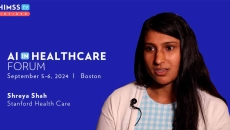Workforce
Nursing and IT
The technology aligns closely with the health system's perinatal safety initiatives and focuses on continuous improvement to ensure clinical teams are aligned on evidenced-based practice. It's assessment-based and provides personalized learning.
HIMSS24 APAC
Started amid the recent pandemic, smart hospitals are now being expanded nationwide.
However, data from the Australian Digital Health Agency shows a general increase in the use of the national digital health record system.
Dr. Shreya Shah, medical informatics director at Stanford Health Care, says higher-value, lower-risk use cases like automated draft replies to patient messages and ambient AI scribes are improving the care experience for providers.
HIMSS24 APAC
Seoul National University Hospital CIO Dr Hyung-Chul Lee gives a peek into the future of medical education.
Just like airline pilots, physicians will come to rely more on automation – but pilots and doctors always will be needed, MedPearl's physician founder says.
Most health systems experienced a cyberattack in the last year, the new Ponemon Institute report shows, with 69% of victims citing poor patient outcomes. Business-email compromise and ransomware were reported to be the biggest culprits in care impacts.
Success Stories & ROI
Once they're found, "we can systematically improve processes," says the health system's patient experience lead, helping move the needle on quality improvement, team member engagement and more.
HIMSS' new Policy Principles for Artificial Intelligence and Machine Learning focus on safety and trust; transparency and privacy; and workforce and sustainability. Jonathan French, senior director of public policy at HIMSS explains more.
Nursing and IT
Hadassah Backman, RN, is a nurse CEO who says artificial intelligence could do a lot to help RNs with relentless documentation burden, while also helping organizations boost revenue and improve compliance.









